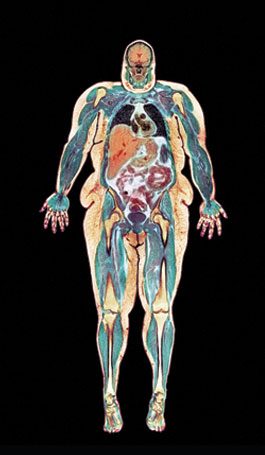The Economics of Obesity

According to Chad Meyerhoefer's study, adult obesity raises annual medical care costs in the U.S. by $315.8 billion.
Obesity rates have more than doubled in the U.S. in the past 30 years. A significant risk factor for diabetes, cardiovascular disease and other clinically significant health problems, obesity accounts for almost 21 percent of U.S. healthcare costs. Chad Meyerhoefer, associate professor of economics, and a team of researchers have added new understanding to the obesity epidemic and its costs.
Quantifying how much obesity increases medical costs is difficult. Previous obesity studies were skewed because they failed to account for poverty and erroneous reporting, Meyerhoefer says. Obesity rates are higher among low-income populations, who tend to have less access to healthcare, for instance.

“If you don’t address those issues, then you’re going to significantly underestimate the cost,” Meyerhoefer says.
Meyerhoefer and his colleagues—Lehigh doctoral student Adam Biener, John Cawley of Cornell University, and Mette Hammer and Neil Wintfeld of Novo Nordisk, Inc.—developed a methodology to correct existing models for those two factors using data from the Medical Expenditure Panel Survey, 2000-2010. They studied data involving adults with and without diabetes.
The team found that the greatest savings in medical costs occurred when morbidly obese individuals with diabetes lost between 5 and 10 percent of their body mass index.
Surprisingly, when the researchers compared medical costs associated with men who were in the low end of the obese range with men who were of normal weight, there was essentially no increase in cost, Meyerhoefer says.
Instead, the researchers found a nonlinear relationship between weight gain and medical costs.
“We thought we’d see an elevation in cost as people became overweight. You don’t see that. Costs don’t go up until you get into extreme obesity,” he says.
The study found that a relatively small percent of the population, those with the highest BMI and classified as having class 3 obesity, generate most of the medical costs of obesity.
Meyerhoefer and his team also found that the medical costs of obesity in the United States are much higher—nearly $316 billion a year— than previous studies had shown. To put it in perspective, that’s about the annual cost of Parts A and B of the Medicaid program combined. In addition, the study found the average cost to treat obese individuals has risen 14 percent since 2005.

Meyerhoefer says the study can be used by researchers, policy makers, health insurers, employers and government agencies to calculate the cost-effectiveness of interventions to prevent and treat obesity.
By encouraging employees to avoid weight gain, for example, companies can save money and write off some of the costs by implementing a workplace weight loss program through subsidies provided through the Affordable Care Act.
“Empirically, you don’t see a lot of cost savings from weight loss because most people gradually gain weight over time. As a result, most of the potential savings are from avoided weight gain, rather than weight loss, per se,” Meyerhoefer says.
The study, “Savings in Medical Expenditures Associated with Reductions in Body Mass Index Among U.S. Adults with Obesity, by Diabetes Status,” was published in the journal PharmacoEconomics in 2014. Along with another study in the Journal of Health Economics, it has become one of the most cited on the topic. The American Heart Association and the Institute of Medicine are among those who have adopted the findings.
Key findings:
• The average inflation-adjusted annual medical care costs of adult obesity in the United States rose from $3,070 in 2005 to $3,508 in 2010—an increase of 14.3 percent.
• Adult obesity raises annual medical care costs in the U.S. by $315.8 billion (2010).
• Individuals with class 1 obesity (low risk) with a BMI of 30, do not have elevated healthcare costs, but rise rapidly with individuals with class 2 obesity (moderate risk) or class 3 obesity (high risk) with a BMI of 35 or greater.
• The estimated savings in annual medical care costs from a 5 percent reduction in weight is $2,137 for those with a starting BMI of 40; $528 for those with a starting BMI of 35 and $69 for those with a starting BMI of 30.
• The medical care costs for individuals with diabetes are greater than for those without diabetes at every unit of BMI, and, at high levels of BMI, this difference amounts to thousands of dollars per year.
*Novo Nordisk provided financial support for this study.
Chad Meyerhoefer’s research interests include the economics of health and nutrition, and much of his work involves the use of microeconometric methods to evaluate and inform public policy. He received his Ph.D. from Cornell University.
Story by Wendy Solomon
Posted on:






